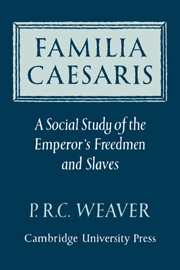Book contents
- Frontmatter
- Contents
- Preface
- Abbreviations
- INTRODUCTION
- PART I NOMENCLATURE AND CHRONOLOGY
- PART II THE FAMILY CIRCLE
- 5 Age at manumission
- 6 Age at marriage
- 7 Status of wives
- 8 Status of children
- 9 The Senatusconsultum Claudianum and the Familia Caesaris
- 10 Women in the Familia Caesaris
- 11 The marriage pattern of slaves and freedmen outside the Familia Caesaris
- PART III THE EMPEROR'S SERVICE
- APPENDIXES
- Bibliography
- Index
10 - Women in the Familia Caesaris
Published online by Cambridge University Press: 07 October 2011
- Frontmatter
- Contents
- Preface
- Abbreviations
- INTRODUCTION
- PART I NOMENCLATURE AND CHRONOLOGY
- PART II THE FAMILY CIRCLE
- 5 Age at manumission
- 6 Age at marriage
- 7 Status of wives
- 8 Status of children
- 9 The Senatusconsultum Claudianum and the Familia Caesaris
- 10 Women in the Familia Caesaris
- 11 The marriage pattern of slaves and freedmen outside the Familia Caesaris
- PART III THE EMPEROR'S SERVICE
- APPENDIXES
- Bibliography
- Index
Summary
What was the role of women – the Augusti libertae and Caesaris servae – in the Familia Caesaris and how does their status compare both with that of the Augusti liberti and Caesaris servi on the one hand, and with that of women of the slave and freed classes outside the Familia on the other?
Libertae in general in Roman society show a much more marked upward mobility in status than servi or liberti. One important aspect of this mobility, marriage with one's patron, needless to say was denied to the Aug. libertae, but not to the Aug. lib(erti) libertae, the freedwomen of Imperial freedmen, who very frequently marry their freedman patron. The well-known case of Acte, the freedwoman concubine of Nero, belongs to the exceptional personal history of that emperor. But Vespasian also had a famous concubine, Caenis the freedwoman of Antonia Minor. He lived with her after the death of his wife Flavia Domitilla, and he maintained her without embarrassment as a de facto wife till her death (Suetonius, Vesp. 3: ‘paene iustae uxoris loco’; cf. ib. 21). Another freedwoman, Lysistrata, was concubine of no less revered an emperor than Antoninus Pius after the death of his wife Faustina. Lysistrata, a freedwoman of Faustina no less, indeed appears in an inscription after Pius' death with the actual title ‘concubina divi Pii’ (VI 8972 = d 1836: Galeria [Aug(ustae) liber]tae Lysistrate concubina Divi Pii).
- Type
- Chapter
- Information
- Familia CaesarisA Social Study of the Emperor's Freedmen and Slaves, pp. 170 - 178Publisher: Cambridge University PressPrint publication year: 1972



